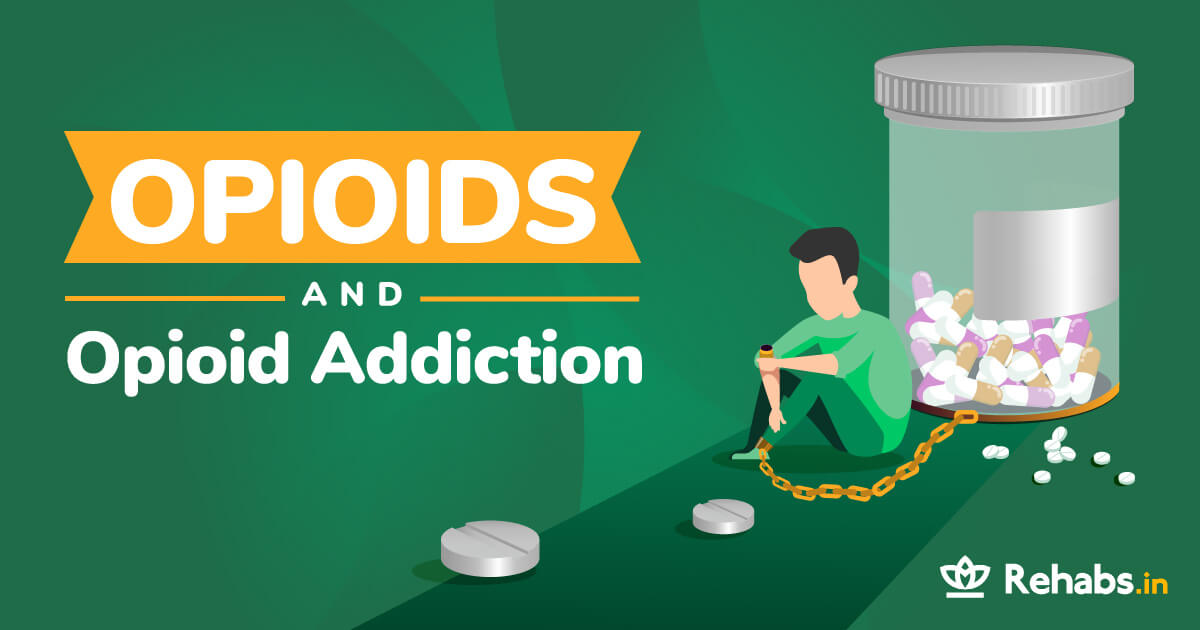Opioids and Opioid Addiction Explained

The following blog has been reviewed by a Psychologist. If you are reading the blog on a mobile phone, you can see the reviewer’s profile at the end of the blog. Please see our editorial policy here.
Opioid misuse has become a common scenario across the globe. Other than prescription doses, these drugs are also used for pleasure-seeking purposes, which has caused a severe opioid addiction crisis. The risk of addiction and dependence has grown exponentially due to its misuse.
What Are Opioids?
Opioid, also known as narcotics, is a class of drug that is generally used for the treatment of chronic or severe pain diseases. The drug functions on opioid receptors to produce effects similar to morphine. The opioid receptors bind with the protein in the brain nerve cells, spinal cord, and other body parts, thereby blocking the pain signal transmission by the neurons through the body’s central nervous system. Hence, relieving pain.
Some examples of opioids that are legally used by prescription and illicitly used include the use of heroin, fentanyl, morphine, oxycodone, and hydrocodone.
What Is Opioid Addiction?
While opioids are effective against relieving pain, they may carry some risks that can be highly addictive. Opioid addiction is an overwhelming appetite for continuous use of opioids despite having harmful consequences.
[Read more — Other Types of Drug Addiction]
Its peril is especially high when they are used for treating chronic pain over a long duration. Sometimes, opioid analgesics like Abstral, Codeine, and Demerol are also given to the people who suffer from severe chronic pains.
[You may also like to read — How to Recognise Opioid Overdose?]
Why Are Opioids Addictive?
Opioids act as a catalyst for the release of endorphins, which makes a person feel good by sending such signals to the brain through neurotransmitters. When opioids are used for a long duration, it causes the person to seek the same pleasure routinely, thereby causing addiction.
Misusing such drugs can lead to severe addiction problems and dependence.
History of Opioids
The use of opioids dates back to centuries as it is amongst the oldest known drugs available on the planet, having early evidence from the neolithic period (between 5500-5700BC). During the 4th century, opium poppies were used for medical, recreational, and religious purposes. By 1590 AD, it became a staple crop in India during the spring season.
Between 1797 and 1949, cultivation and manufacturing of opium in India was regulated and controlled by multiple acts introduced and modified during the period. Opium was moving legally and illegally across Indian sub-continent and other parts of the world including the Portuguese, the Dutch, China, and the British Empire.
Similar other opioids like morphine, codeine, and synthetic opioids moved across the world in a related manner. Initially, they were all being used for medicinal and recreational purposes without considering its addictive effects.
After observing opioid addiction and dependence for a long time, finally in the 1980s, WHO published guidelines for narcotics- all-inclusive, to regulate prescribed drugs for different doses for various illnesses. In 2014, the Indian government also revised the NDPS Act for opioid regulation.
Common Opioid Drugs of Indian Market
Natural Opioids
- Heroin (Diamorphine)
- Morphine
- Codeine
- Thebaine
- Papaverine
Synthetic Opioids
- Fentanyl
- Hydromorphone
- Meperidine
- Methadone
- Oxymorphone
- Oxycodone
- OxyContin
- Vicodin
Addiction to Opioids
For most people, the initial decision of taking drugs is voluntary. Once the addiction is caused due to persistent use, it can lead to brain alterations, which further challenges a person’s self-control capabilities. Besides, opioid addiction also interferes with a person’s ability to resist a strong impulse to take drugs. With time, she/he may even start to show a few significant symptoms of opioid addiction, which can cause a significant social, personal, and financial crisis.
Methods of Use
Opioids tend to cause a sense of euphoria in an individual, whose constant use can lead to its dependence. One of the commonly used opioids is heroin. They usually become more addictive when taken in different ways other than the methods prescribed by a medical officer.
Here are some of the other ways it is generally consumed in:
- Through injecting IV
- Vaporising
- Sniffing
- Used as a suppository
- Ingested orally
First three methods of use are usually standard to create an instant euphoric effect, although all the means of intake can become addictive.
Opioid Addiction — India Case Study
According to 2019 report by GOI, a survey was conducted by AIIMS in 36 states and union territories to know the extent and pattern of substance abuse in the country. Respondent Driven Sampling (RDS) was done with the help of the Household Sample Survey (HHS) to understand the dependence of people between 10-75 years on illicit drugs. The data was produced and analyzed for alcohol, cannabis, opioids, cocaine, amphetamine, sedatives, inhalants, and hallucinogens.
Key Findings for Opioid Addiction in India
- India has 2.3 Crore (i.e. 2.1%) users of all kinds of opioids
- 77 Lakh (0.70%) are problem users
- 28 Lakh (0.26%) are dependent users
- Heroin (smack or brown sugar) is the most common opioid which has 1.14% of dependent users
- 0.96% of people abuse pharmaceutical drugs
- 0.52% of people abuse opium (poppy husk) in the country
Opioid Addiction Causes
Taking opioids more than the prescribed dose can cause addiction. However, it also has the same result when used illicitly. Sometimes, rapid delivery of huge quantities to your body may lead to opioid overdose, which can increase the risk of losing a life. The extended period of use of opioid plays a crucial role in developing the risks related to its addiction. Besides, essential factors playing a role in developing opioid addiction are – psychological, genetic, and environmental.
Some factors responsible for developing opioid addiction are:
- Young age
- Poverty
- Unemployment
- Family history of substance abuse
- Legal issues or criminal history
- Mental disorder
- Adventure-seeking behaviour
- Heavy tobacco use
- Living in stressful circumstances
- Drug or alcohol rehabilitation history
- Peer pressure
Possible Signs and Symptoms of Opioid Addiction
- Changing groups or friends quickly
- Avoiding friends and family to stay alone
- Losing interest in doing other activities apart from taking drugs or craving it
- Sitting idle and tired
- Not taking care of personal hygiene
- Staying cranky or having mood swings
- Unusual sleeping and diet habits
- Facing a financial crisis
- Increasing problems at school or work
- Missing essential dates
Side Effects of Opioid Abuse and Addiction
Opioids reduce discomfort and anxiety for a short period by building a feeling of bodily and mental numbness. High doses are capable of causing short-lived euphoria followed by drowsiness. The momentary elevated feelings achieved makes it challenging to discontinue its use, hence developing an opioid addiction. Heroin is one of the commonly abused most addictive opioids.
As a result of this developed addiction, some of the common side effects are:
- Itching and constipation
- Drowsiness
- Respiratory depression
- Increased pain sensitivity
- Nausea and vomiting
- Lowered sex hormone levels
- Interruption at work
- Reduced focus
- Dizziness and headache
- Impaired immune function system
Diagnosis and Treatment of Opioid Addiction
A person suffering from opioid addiction generally shows some of the above signs combined with indifferent behaviour. If you undergo opioid addiction or know of someone who is currently facing this situation, the initial step you must take them to a psychologist or a licensed drug counsellor to determine the problem. It can further help in getting the best possible treatment to overcome the addiction problem.
Opioid addiction is a complex disease that can affect a person in more than one way. Although there is no antidote for it, there are many treatment options that can help overcome this problem.
Some treatment options for opioid addiction are:
1. Detoxification
It is the initial step towards prolonged treatment. Detoxification is usually useful when done in combination with other treatment options, like taking therapies or medication. It requires support and will power during the entire withdrawal process under supervision.
Some people may suffer anxiety, stress, body tremors, sleep disturbance and body pain.
2. Medication
Few people successfully come out of their addiction by taking prescription drugs in a controlled amount taken under supervision. It not only helps them slow down their daily drug dosage but also helps them in reducing its use, thereby, overcoming eventually.
Some of the prescription drugs used for medicinal purposes are methadone and buprenorphine. It is also known as replacement therapy for opioid addiction, which lessens withdrawal symptoms as well.
Treatment Facilities
There are many treatment centres where all facilities are provided for individuals to overcome their drug addiction. It is usually preferred in worst-case scenarios, especially in opioid overdose cases.
During this period, an individual can join a vocational rehab facility, a support group, and various therapies to overcome their problems.
Opioid Addiction — Recovering Journey
Individuals who are opioid addicts or take opioid overdose are at higher risk of endangering their lives. They need help and support from their friends and family to overcome such situations. Opioid addiction can lead to a significant effect on their mental and physical health. Therefore, it is essential to understand their problems rather than finding faults. How soon will they recover? It depends on an individual’s drug intake history.
Until then, identify such people in your circle and offer them your support.
Reference Sources
https://www.asahq.org/whensecondscount/pain-management/opioid-treatment/what-are-opioids/
http://nicfs.gov.in/wp-content/uploads/2017/01/Narcotics-Drugs-and-Psychotrophic-Substances.pdf
https://en.wikipedia.org/wiki/Opioid#History
http://mpsja.mphc.gov.in/Joti/pdf/LU/NDPS%20SINGH%20SIR.docx%20corrected.pdf
http://socialjustice.nic.in/writereaddata/UploadFile/Magnitude_Substance_Use_India_REPORT.pdf














